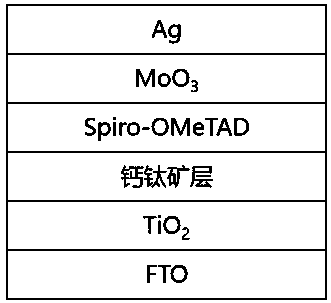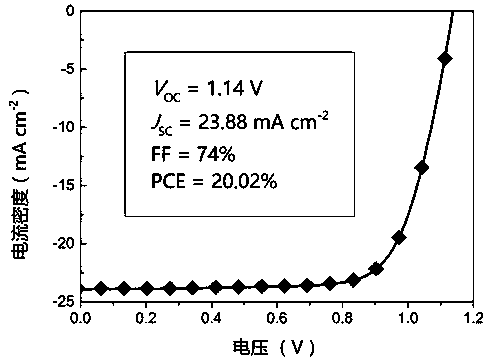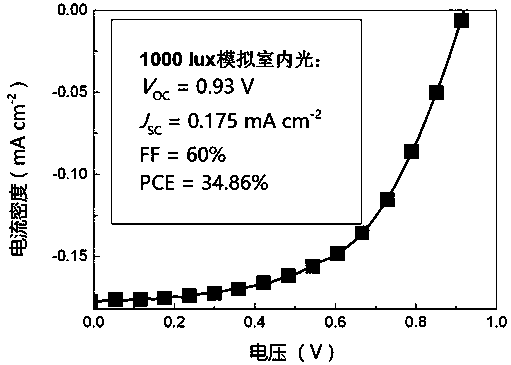Non-halogen lead-doped perovskite thin film and preparation method and application thereof
A perovskite and perovskite precursor technology, applied in the field of solar cells, can solve problems such as hindering carrier transport recombination, affecting battery performance, and obvious grain boundaries, so as to slow down the nucleation and growth rate and improve device efficiency , the effect of grain boundary reduction
- Summary
- Abstract
- Description
- Claims
- Application Information
AI Technical Summary
Problems solved by technology
Method used
Image
Examples
Embodiment 1
[0031] (1) Clean the FTO ultrasonically twice with detergent, ethanol and acetone, each time for 15 min. Then put it into an oven to dry to remove residual moisture and organic solvent;
[0032] (2) Methylammonium iodide (MAI) and lead chloride (PbCl 2 ) was dissolved in a mixed solvent of γ-butyrolactone (GBL) and dimethyl sulfoxide (DMSO) with a volume ratio of 7:3 at a molar ratio of 3:1, and stirred for 3 h to obtain a 30wt% perovskite precursor solution. In addition, prepare 20 mg / mL lead oxalate (PbC 2 o 4 ) of hydrochloric acid solution, shake until completely dissolved;
[0033] (3) Mix the perovskite precursor solution and the lead oxalate solution at a volume ratio of 20:1 to obtain a mixed solution. Then mix the mixed solution with the perovskite precursor solution according to the volume ratio of 20:3, and finally obtain the perovskite precursor solution with lead oxalate as an additive;
[0034] (4) Pour an ice-water mixture of titanium dioxide on the FTO su...
Embodiment 2
[0039] (1) Clean the FTO ultrasonically twice with detergent, ethanol and acetone, each time for 15 min. Then put it into an oven to dry to remove residual moisture and organic solvent;
[0040] (2) Combine MAI with PbCl 2 Dissolve in the mixed solvent of GBL and DMSO with a volume ratio of 7:3 at a molar ratio of 3:1, and stir for 3 hours to obtain a 30wt% perovskite precursor solution. Alternatively, prepare 20 mg / mL lead oxalate (PbC 2 o 4 ) of hydrochloric acid solution, shake until completely dissolved;
[0041] (3) Mix the perovskite precursor solution and the lead oxalate solution at a volume ratio of 20:1 to obtain a mixed solution. Then the mixed solution is mixed with the perovskite precursor solution according to the volume ratio of 20:5, and finally the perovskite precursor solution with lead oxalate as an additive is obtained;
[0042] (4) Pour an ice-water mixture of titanium dioxide on the FTO substrate, put it in a 75°C oven for 1 hour, then blow dry the s...
Embodiment 3
[0047] (1) Clean the FTO ultrasonically twice with detergent, ethanol and acetone, each time for 15 min. Then put it into an oven to dry to remove residual moisture and organic solvent;
[0048] (2) Combine MAI with PbCl 2 It was dissolved in a mixed solvent of GBL and DMSO with a volume ratio of 7:3 at a molar ratio of 3:1, and stirred for 3 h to obtain a 30wt% perovskite precursor solution. Alternatively, prepare 20 mg / mL lead oxalate (PbC 2 o 4 ) of hydrochloric acid solution, shake until completely dissolved;
[0049] (3) Mix the perovskite precursor solution and the lead oxalate solution at a volume ratio of 20:1 to obtain a mixed solution. Then the mixed solution is mixed with the perovskite precursor solution according to the volume ratio of 20:5, and finally the perovskite precursor solution with lead oxalate as an additive is obtained;
[0050] (4) Pour an ice-water mixture of titanium dioxide on the FTO substrate, put it in a 75°C oven for 1 hour, then blow dry ...
PUM
 Login to View More
Login to View More Abstract
Description
Claims
Application Information
 Login to View More
Login to View More - R&D
- Intellectual Property
- Life Sciences
- Materials
- Tech Scout
- Unparalleled Data Quality
- Higher Quality Content
- 60% Fewer Hallucinations
Browse by: Latest US Patents, China's latest patents, Technical Efficacy Thesaurus, Application Domain, Technology Topic, Popular Technical Reports.
© 2025 PatSnap. All rights reserved.Legal|Privacy policy|Modern Slavery Act Transparency Statement|Sitemap|About US| Contact US: help@patsnap.com



